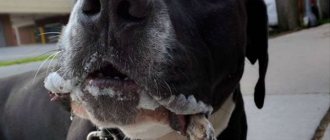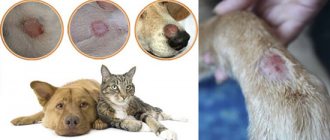Poisonous snakes living in Russia
There are significantly fewer poisonous reptiles on the territory of the Russian Federation than in Asia or Africa, but all of them are dangerous to humans and animals.
Poisonous snakes:
common copperhead;- Ussuri copperhead;
- rocky muzzle;
- tiger snake;
- common viper;
- Caucasian viper;
- Dinnik's viper;
- steppe viper;
- Nikolsky's viper;
- viper
Black viper - the most dangerous
The black viper, or Nikolsky's viper, lives in the European part of Russia, forest-steppes and steppes, at the foothills of the Middle and Southern Urals. The reptile's activity occurs during the daytime.
The poison is dangerous because when it gets into the blood, it destroys red blood cells. The viper is very dangerous for small animals, since snake venom quickly spreads through the circulatory system, it is enough to kill a small animal or a child.
Cottonmouth
This type of snake does not show aggressiveness, but will definitely attack if you step on it.
Cottonmouth bites cause hemorrhages in the internal organs, and ulcers also appear in places where teeth are punctured. Neurotoxins paralyze the nervous and respiratory systems. Children and small animals are especially likely to die from a copperhead bite.
If you provide first aid and start treatment in a timely manner, the victim’s condition will improve within a week.
How to give first aid to a dog?
Any snake bite for a dog is very dangerous and requires immediate hospitalization. Until the animal is taken to the veterinary clinic, first aid must be provided:
- If a limb is injured, apply a tight tourniquet to prevent the spread of the poison.
- Try to immobilize the dog. Muscle activity causes toxins to spread more quickly.
- Squeeze out as much blood as you can from the wounds.
- Treat the bite with any antiseptic and apply ice or gauze soaked in cold water.
- Give your pet a drink by pouring water into its mouth and let it swallow as much as it can. The more water your dog drinks, the better.
- If your dog begins to shiver (sometimes body temperature and blood pressure drop sharply), cover him. You can determine the temperature by looking at your nose.
Properties of snake venom
It is a complex mixture of organic and inorganic substances produced by the glands of poisonous snakes.
The poison has a neurotoxic effect: it blocks the transmission of signals from the brain to the muscles, the animal or person dies from paralysis.
The second property is a hemovasotoxic effect. After snake venom enters the blood, vascular spasm occurs, arteries become permeable, and swelling of tissues and internal organs occurs.
How does snake venom affect dogs?
If you are bitten by a dog: what to do legally
Is a viper bite dangerous for a dog? According to its effect on a living organism, snake venom is divided into two types:
- Neurotoxic. Toxic substances, penetrating into the bloodstream, block muscle receptors, including respiratory ones. If assistance is not provided in a timely manner, the pet will die from suffocation caused by paralysis. The neurotoxic venom is found in the saliva of cobras and a large number of sea snakes.
Site of a snake bite on a dog
- Hemovasotoxic. Toxic substances provoke spasm of blood vessels and increase the degree of their permeability. The bite site is characterized by real hemorrhage. If measures are not taken in a timely manner, blood vessels will gradually begin to burst in vital internal organs - the brain, lungs, kidneys and liver. Toxic substances cause agglutination of red blood cells, which slows down blood flow and, accordingly, the delivery of oxygen to tissues. Against the background of oxygen starvation, necrosis (death) of living tissues is observed. This poison is contained in the saliva of vipers and vipers.
Note! It is better for the dog owner to first familiarize himself with the features of first aid in extreme situations, because minutes of delay can take the life of a family member.
How to tell if your dog has been bitten by a snake
Usually the upper part of the body is injured: the area of the head, neck or muzzle, and animal paw bites are not uncommon.
Inspection
It is necessary to examine the animal as quickly as possible and find the site of the bite. If a dog is attacked by a poisonous snake, the damage is extensive and 2 punctures are found. The site of injury swells, tissue swelling appears, blood begins to ooze, and the animal whines in severe pain.
If the dog encounters a non-venomous snake, the wound will look like an injection and will not cause much discomfort.
Important symptoms
After repeated snake bites, 2–4 or more wounds remain. The skin around them acquires a purple tint and later becomes insensitive. Within a minute, a large, painful swelling forms.
The swelling spreads to the entire face or paw, the animal limps, behaves restlessly, indicating that it is in severe pain.
Half an hour later, the dog has difficulty swallowing, rapid heartbeat, shortness of breath, and convulsions. Vomiting, bleeding from the gums, and lethargy followed by restless behavior are less common.
First aid for a viper bite
It's easy to write - take the dog to the veterinary clinic as quickly as possible. But what if it takes several hours to get to the doctor, or if he is not in your locality at all? You can help your dog yourself.
- Don't let the dog move.
There is no point in making a splint or bandaging a bitten paw. It is better to take your pet in your arms, not allowing him to walk on his own, and take him out of the forest. If the dog is large, take it on a leash and slowly walk to the car.
Swelling of a dachshund's paw after a viper bite
- Antihistamines
The dog should be given any allergy medication: Suprastin, Tavegil, Loratadine, Zyrtec, Cetrin, Diphenhydramine. In this case, injections are preferable to tablets. Injections act faster, plus the dog may vomit and have depression of consciousness. Don’t be afraid to overdo it with the dosage; don’t compare the size of your pet and an adult. The dose of Suprastin for small dogs is 0.5-1 mg/kg.
If you regularly take your dog into the forest, or there is high snake activity in the area, you should have drugs from the group of corticosteroids in your first aid kit: Dexamethasone, Prednisolone, which are administered intramuscularly (into the thigh).
For small dogs, the dose of Dexamethasone is 0.1 ml per 1 kg; for medium dogs 10-30 kg - 1 ml, for large dogs - 2 ml.
Ampoules for a home first aid kit: diphenhydramine, prednisolone, analgin
- Fluid therapy
The dog is allowed to drink ad libitum; you can dilute the drug Regidron and force-drink it from a syringe. It is more effective to administer solutions subcutaneously at 10-20 ml/kg for small dogs (saline solution, Ringer, 5% glucose).
Saline solution should be in every first aid kit!
- Anesthesia
A sharp disruption of blood circulation at the site of the bite causes hellish pain. You can inject your dog with analgin (1 mg/kg), baralgetas, spasmalgon (for small breeds, the dose is 0.1 ml per 1 kg).
What happens after a bite
Consequences after a snake attack: blood flowing from damaged skin forms clots, the poison remains in the wound and is carried through the bloodstream.
The red blood cells inside the wound coagulate under the influence of the poison, oxygen does not reach the tissues, as a result of which they die. In the bites left by reptiles, non-healing painful ulcers develop and the skin peels off.
More severe consequences: an allergic reaction and anaphylactic shock, the dog dies within a few minutes. If a snake's teeth get into a vessel, the poison spreads faster through the bloodstream, causing irreversible changes.
The pet's death occurs within 48 hours after the bite.
Signs of a snake bite
A cat was bitten by a snake: what to do, symptoms
Symptoms of a bite in a dog may vary depending on what type of snake bit it. Soon after the bite, the dog will jump to the side with a squeal, begin to tuck its tail and whine, licking the affected area without stopping. The main symptoms of hematovasotoxic attack:
- Increased heart rate, indicators constantly stray from the normal rhythm. Against this background, dysphagia develops.
- There is severe swelling of the tissue at the site of the bite. The tissues swell and two distinct red dots are visible - traces of the snake's teeth. Ichure and blood ooze from the wounds.
- In severe situations, the dog’s gums begin to bleed and vomit.
Note! It is important for every dog breeder to know how first aid is provided to a dog in case of a snake bite, because before going to the veterinary clinic, urgent measures need to be taken.
First aid
You need to react quickly. Sucking the poison from the wound or blocking the blood flow with a tourniquet is useless.
First aid should consist of preparing the pet for examination by a veterinarian:
- The animal is calmed down, talked to, taken to a safe place, and prepared for the veterinarian’s arrival.
- The dog is immobilized and placed on its side: this way the poison spreads more slowly throughout the body.
The owner examines her and finds the bite site.- If the owner is sure that the snake attacked the dog no more than 20 minutes ago, the poison can be squeezed out of the wound: the substance is still there and has not been spread by the blood throughout the body.
- Call a veterinarian or take the animal to the clinic. In this case, you cannot self-medicate.
The owner should not panic. If the dog is large, then the dose of poison that the snake injects in defense at one time is not enough to cause death.
A small pet may suffer more.
Good to know
Forewarned is forearmed. It is useful for dog owners to take note of the following information, which is directly or indirectly related to the “snake” topic:
- Of all the snakes living in the middle latitudes of Russia, only two species pose a real danger - the viper and the copperhead.
- A bite from an adult snake is much more serious than a bite from a young snake that has recently hatched from an egg. This is explained by the higher concentration of the toxin contained in the poison and which specifically affects the heart muscle.
- Breeds with light skin are most sensitive to snake venom. Hunting dogs, dachshunds, and mestizos, on the contrary, are resistant to toxins and can recover even without medical intervention.
- The larger the dog, the slower the poison is absorbed.
- Animals do not develop immunity to snake bites. With each repeated incident, the dog is not immune from serious consequences.
- The reaction to snake venom depends on the location of the bite. Cases where the tongue, neck, and lip are usually affected quickly lead to death.
It is important to remember that the life and health of a dog directly depends on how quickly it is taken to the veterinarian. The time and professionalism of the doctor are of decisive importance.
What not to do
Many dog owners, when they discover snake bites, begin to panic and make mistakes that can lead to dire consequences:
A tourniquet is applied. When tissue is compressed, the concentration of poison increases; as soon as the tourniquet is released, the substance rapidly spreads throughout the body through the bloodstream.- They try to suck out the poison from the wound: it is difficult to find the bite site, the dog will not always let you touch it.
- Treat wounds left after snake bites. This is useless and may increase pain. Antiseptic solutions containing alcohol and ethers enhance the absorption of toxins.
The only thing the dog owner can do is apply ice wrapped in a towel to the wound. This slows down metabolic processes at the site of poison injection and reduces pain in the pet.
Events at the veterinary clinic
At the clinic, an intravenous catheter will be installed for the pet to administer medications and give IVs. Traditionally, antiprotease drugs (Kontrikal, Gordox) are added to saline solutions, but their effectiveness has not been proven.
The dog will be given decongestants and an allergy medicine (the best is diphenhydramine 0.5-2 mg/kg 3 times a day).
Intravenous infusion for dachshunds at home
In case of anaphylactic shock, you must act very quickly. The first is epinephrine 0.1 mg/kg intramuscularly, and if it is not available, adrenaline. Then glucocorticoids are administered intravenously (methylprednisolone 30 mg/kg, prednisolone 15 mg/kg, dexamethasone 0.5 mg/kg), aminophylline 6-10 mg/kg (to relieve spasm of the respiratory tract). If necessary, a tube is placed in the pet's trachea and oxygen is supplied, or the animal is placed in an oxygen chamber.
If the dog feels satisfactory, it is sent home, but the administration of drugs should continue for another 2 to 5 days (prednisolone 1 mg/kg 2 times a day or dexamethasone 0.1 mg/kg).
If the condition is serious, it is better to leave your pet in a 24-hour hospital. Doctors will monitor whether enough urine is being produced after drips and, if necessary, additionally prescribe diuretics (furosemide).
It is very good if the clinic has:
- the ability to measure blood pressure in dogs; in case of a sharp decrease, dopamine and colloidal solutions (Refortan) are used;
- continuous oxygen supply (chamber for small dogs, oxygen tent or mask for large dogs);
- infusion pumps for continuous administration of water-salt solutions at a given speed.
As for the bite site, it is injected with 0.5% novocaine. The blockade not only slightly reduces pain, but also stops the spread of tissue damage. An antibiotic (ampicillin, oxamp, cefazolin) is added to novocaine.
After a snake bite, you need a course of systemic antibiotics. Deep bite wounds into which saliva has entered always become inflamed. If the bite is on the paw, apply a bandage, but it is very important not to disrupt the blood flow in the limb.
The dachshund was bitten by a snake. Applying a bandage to the paw is almost impossible.
Swelling of the paw after a snake bite
Many questions arise about the use of antidote. The truth is that veterinarians very rarely use snake antiserum.
Most often, the drug is simply not available. Serum is rarely needed and is stored for 1-2 years, so clinics do not purchase it. The anti-viper serum is not suitable; a serum against the common viper is needed. Although it is produced in Russia (in Stavropol), it is difficult to find on the open market.
Common viper. The viper belongs to the viper family, but these are different snakes!
The second, main reason is that horse serum itself is a strong allergen. Its administration can cause anaphylactic shock in the dog. In other words, the expected benefit is not commensurate with the risk.
If the doctor decides to use serum, the dog will first be given an antihistamine, then a test will be performed (0.1 ml of the drug subcutaneously). After a few minutes, another 0.2 ml is injected and observed. If there is no reaction, the full dose is administered intravenously. Owners are warned that allergic reactions may not develop immediately, but after 2-10 days.
Veterinarian actions
The dog is admitted to the hospital.
At the clinic, the doctor conducts a general examination of the pet, assesses its condition, the degree of intoxication, and the functioning of the internal organs. The veterinarian then places an intravenous catheter in the dog through which the necessary medications are administered.
The doctor may prescribe a biochemical blood test to determine the extent of the poison's effect on the pet's body.
If the owner of the animal has determined which reptile attacked the pet, the appropriate antidote is administered at the clinic.
Therapy
If the type of snake is unknown, antihistamines are administered: Dexamethasone, Suprastin. They relieve swelling and reduce allergic reactions.
Furosemide is also prescribed against edema. To maintain blood circulation, the dog is given sodium chloride or Ringer's solution. To protect against secondary infection, antibiotics are administered for a week.
The bite site is anesthetized with Novocaine solution, then the animal is given sedatives. In severe cases, blood or plasma transfusions are recommended.
How to help a dog that has been bitten by a viper?
What can please a dog more than a walk in the fresh air in a park, field or dense green forest? Of course, tailed barking pets simply love to explore new spaces and territories, but it is precisely because of this that they often find themselves in problematic situations. Cases where a dog is bitten by a viper while walking are not at all uncommon. It is simply impossible to insure against such an incident, so dog owners need to be able to provide first aid to their pets in such situations. A viper bite for a dog can be fatal, but such consequences can be avoided.
How to keep your dog safe
Protecting your pet from snake bites is quite difficult. At the moment there are no special repellents or deterrent devices.
It is better to avoid going outdoors in the spring, since it is during this period that snakes are especially active and their venom is concentrated after a long winter.
Young dogs are very inquisitive and playful, and are more likely to become victims of snake bites than their more experienced counterparts.
Dogs of hunting breeds often suffer from snakes, as they mistake them for prey. These pets are closely monitored. It is important to know that these dogs are the least susceptible to snake venom.
It is better not to let very small decorative dogs go “free swimming” at all - such an adventure can be fatal for them.
The dog owner, when going for country walks, should always have a first aid kit with antihistamines, including Suprastin, Allergostop, and corticosteroids (Dexamethasone, Prednisolone).
How to distinguish a viper from a snake
As we said above, the symptoms of a viper bite are very noticeable, in this case it is important that we know which snake has bitten and that we act quickly.
No one is a reptile expert, so it's best to follow the protocol outlined above. However, as a little reference, we can comment on some of the differences between snakes and vipers:
- Snakes have round eyes and large round pupils, just like humans. Vipers have more oval eyes and elongated pupils, like cats.
- Snakes have large scales of varying sizes; vipers have small, uniform scales.
- Snakes, as a rule, have an elongated head commensurate with the body. Vipers usually have a triangular head.
What are the signs of a viper bite?
If the owner himself witnessed how the powerful mouth of a snake closed on the fluffy flesh of his beloved pet, there should be no problems with this point. However, in most cases, things happen a little differently. Veterinarians have identified symptoms that indicate that the dog was bitten by a viper:
- Strange behavior accompanied by loss of orientation, weakness, shortness of breath, apathy and a general depressed state.
- Pain and burning in the affected area, which causes the pet to yelp or growl at a person about to touch it.
- Swelling at the site of the bite usually appears after a few hours; such a powerful inflammatory process is almost impossible not to notice.
Important! There is no need to immediately look for anti-snake serum for your dog, as it must be administered under the strict supervision of a doctor. If it is administered incorrectly, it will cause the inevitable death of your beloved pet.
Only an experienced veterinarian knows what to do in such an extreme situation, so the dog should be sent to a specialized clinic as quickly as possible. However, correctly provided first aid by the owner can also significantly simplify the life of a furry patient.
How to provide first aid to a pet if bitten by a poisonous snake?
First you need to carefully examine the animal to find the site of the viper bite. It usually looks like two bleeding wounds. However, the blood flows only the first time, and then stops. Most bites occur in the head area, but sometimes dogs' paws are also affected if they step on a snake. The most dangerous places for a bite are the neck and tongue. If they swell, suffocation may occur, then the pet dies due to lack of oxygen. To improve the well-being of the injured animal, you need to do the following:
- When there is no doubt that the dog has been bitten by a viper, it is necessary to provide the pet with complete rest. To do this, it must be placed in a large box with high sides or in a special carrier. The dog should be limited in its independent movements, and a splint should be applied to the injured limb.
- The animal must drink a lot. For such purposes, not only ordinary drinking water is suitable, but also a slightly sweetened decoction of chamomile or other medicinal herbs.
- Since it will not be possible to eliminate the negative effects of snake venom on a pet’s body without serum, it is necessary to deal with the consequences of the bite. A veterinarian can best handle such work, but sometimes it is not possible to get to the nearest clinic with a doctor. In such situations, the dog breeder will have to arm himself with a syringe and some drugs for intramuscular injections:
- Antihistamines such as suprastin, tavegil and diphenhydramine are administered intramuscularly.
- Dexamethasone or prednisolone is administered subcutaneously to relieve shock and relieve swelling.
- Corvalol drops are placed directly into the mouth to support the heart.
- For an analgesic effect, intramuscular injections of analgin can be used.
A viper bite, or rather its marks on the skin, must be treated with a light antiseptic that does not contain alcohol. Miramistin, chlorhexidine and furacillin are perfect. It is strictly forbidden to use products containing alcohol, as they only accelerate the absorption of poison into the blood.
If you have the opportunity to contact a veterinarian by phone, you should definitely take advantage of it. He will not only be able to tell you what to do if a viper has bitten a dog, but will also help you do everything to eliminate the negative consequences.











